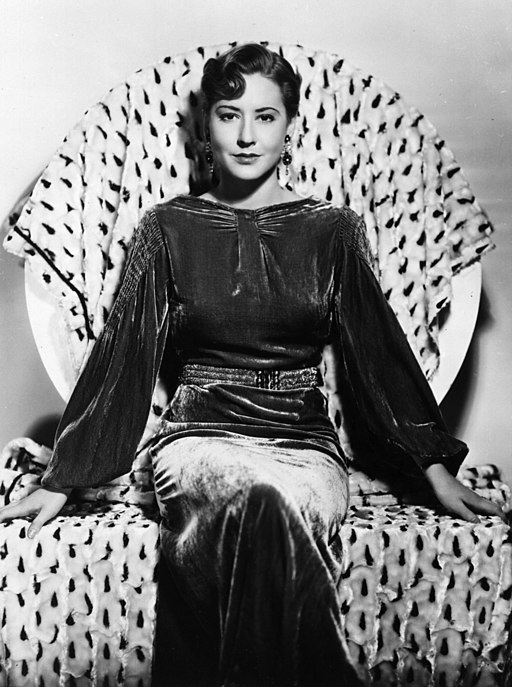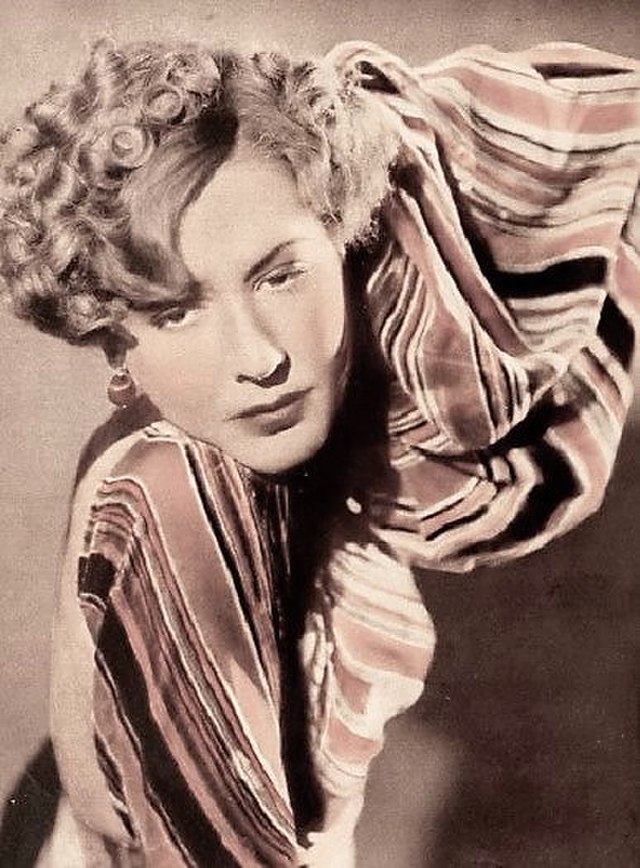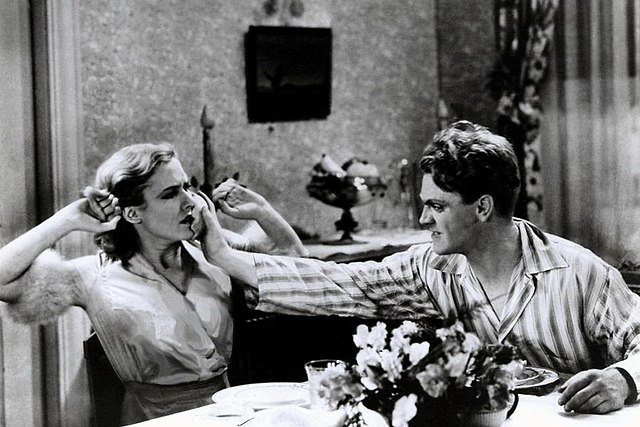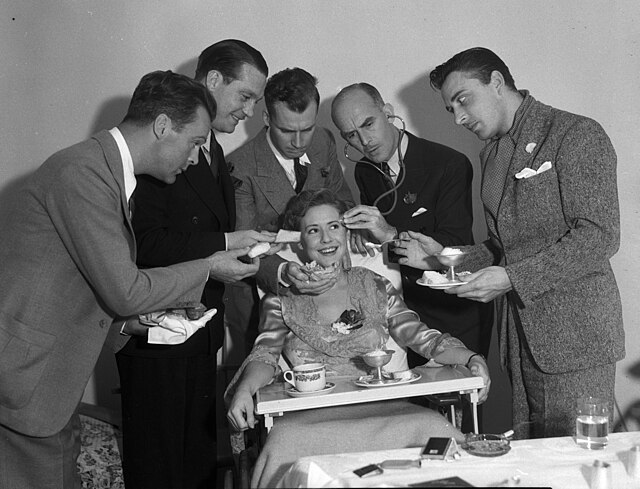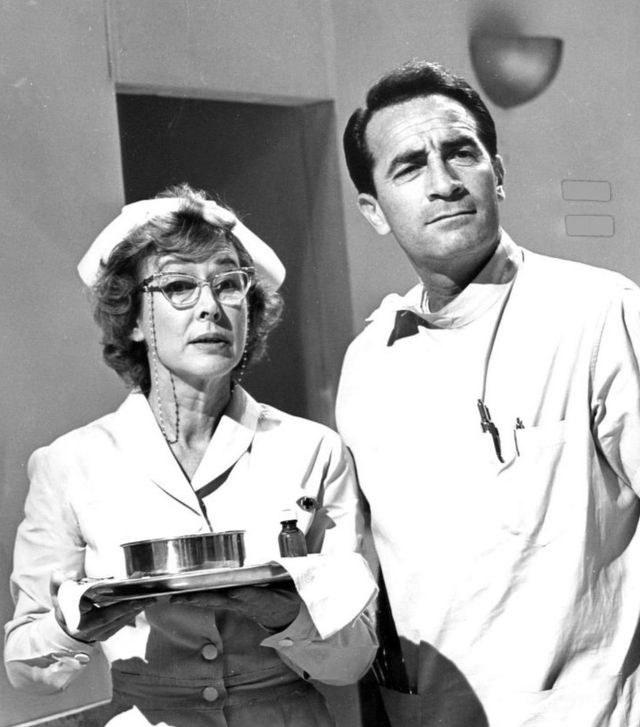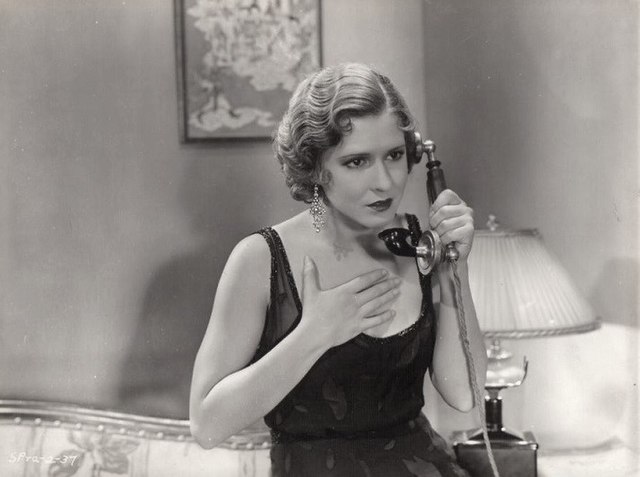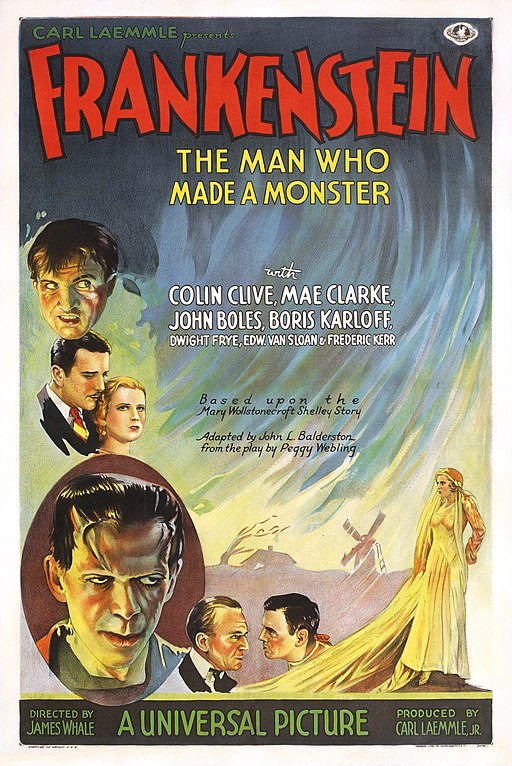Mae Clarke
back| Full Name | Violet Mary Klotz |
| Stage Name | Mae Clarke |
| Born | August 16, 1910 |
| Birthplace | Philadelphia, Pennsylvania, USA |
| Died | April 29, 1992 |
| Buried | Valhalla Memorial Park Cemetery, North Hollywood, California, USA |
| Married to | Lew Brice (1937-1938) - Stevens Bancroft (1946-1949) - Herbert Langdon (1962-?) |
| Children | None |
| Notable films | Waterloo Bridge (1931) - Frankenstein (1931) - The Public Enemy (1931) - Lady Killer (1933) - The Man with Two Lives (1942) - Empire of the Ants (1977) |
Mae Clarke
The Grapefruit Girl
Mae Clarke was a prominent American actress known for her versatile acting skills and memorable roles in the early 20th century.
Clarke's breakthrough came in 1931 when she starred in three significant films: "Waterloo Bridge," "Frankenstein," and "The Public Enemy."
Related
Mae Clarke (1910 – 1992)
Biography and Movie Career:
Mae Clarke, born Violet Mary Klotz on August 16, 1910, in Philadelphia, Pennsylvania, grew up in a modest household. Her parents, a musician and a seamstress, encouraged her artistic inclinations from an early age. Violet, later known by her stage name Mae Clarke, showed an early interest in performing, often entertaining her friends and family with impromptu dance and singing routines.
Her family moved to Atlantic City, New Jersey, where Clarke's mother found work as a wardrobe mistress at a local theatre. This move proved pivotal for young Clarke, who frequently visited the theatre and became fascinated by the world of performance. It was here that she decided to pursue a career in entertainment.
Path Towards Success
Clarke's first professional foray into the entertainment industry was as a dancer in nightclubs and vaudeville shows. Her talent and dedication soon caught the eye of Hollywood scouts, and she moved to California to pursue a career in film. Her early roles were minor, but Clarke's persistence paid off when she signed a contract with Universal Pictures.
Clarke's breakthrough year was 1931, when she starred in three significant films that showcased her versatility as an actress: "Waterloo Bridge," "Frankenstein," and "The Public Enemy." In "Waterloo Bridge," Clarke played Myra Deauville, a tragic character that highlighted her dramatic skills. Her role as Elizabeth Lavenza in "Frankenstein" placed her in the annals of horror film history, and her portrayal of Kitty in "The Public Enemy" included the infamous scene where James Cagney's character shoves a grapefruit into her face, a moment that became iconic in cinema.
While Mae Clarke did not have a widely recognized nickname, she was sometimes affectionately referred to as "The Grapefruit Girl" due to the famous scene in "The Public Enemy" where James Cagney's character pushes a grapefruit into her face. This moment became one of the most memorable in film history, further cementing her place in Hollywood lore.
Marriages and Personal Struggles
Mae Clarke's personal life was as tumultuous as her career was successful. She married three times, each union ending in divorce. Her first marriage to actor Lew Brice in 1937 lasted just a year. Clarke then married Stevens Bancroft in 1946, but the marriage dissolved in 1949. Her third marriage was to Herbert Langdon, though details about this union are sparse.
Clarke's personal life was marked by struggles, including a battle with alcoholism, which affected her health and career. Despite these challenges, she continued to work steadily in Hollywood throughout the 1930s and 1940s, appearing in a variety of films across different genres.
Passions and Later Career
Aside from acting, Clarke had a passion for painting and often spent her free time working on her art. She also had a deep love for animals and supported various animal welfare organizations throughout her life.
As her film career began to wane, Clarke transitioned to television, where she appeared in numerous guest roles on popular shows of the time. She also took on smaller parts in films, ensuring that she remained a working actress for most of her life.
Death and Legacy
Mae Clarke passed away on April 29, 1992, at the Motion Picture & Television Country House and Hospital in Woodland Hills, California. The cause of her death was cancer, a battle she faced with the same resilience that marked her career.
Clarke was buried at Valhalla Memorial Park Cemetery in North Hollywood, California. Her contributions to early cinema, particularly her roles in "Frankenstein" and "The Public Enemy," ensure that she remains a significant figure in film history. Clarke's legacy is one of perseverance and talent, her life a testament to the highs and lows of a Hollywood career. Despite personal struggles, Mae Clarke's work continues to be celebrated by film enthusiasts and historians, preserving her place in the annals of classic American cinema.
Video Tribute to Mae Clarke:
Authentic Acting Style of Mae Clarke:
Mae Clarke's acting style is emblematic of the transitional period in Hollywood during the late 1920s and 1930s, bridging the silent film era and the advent of sound. Her performances are marked by a blend of subtlety and intensity, capturing the complexity of her characters with remarkable depth.
Emotional Authenticity
One of Clarke's standout traits as an actress was her ability to convey deep emotional authenticity. Whether playing the tragic Myra Deauville in "Waterloo Bridge" or the loyal Elizabeth Lavenza in "Frankenstein," Clarke brought a genuine, heartfelt quality to her roles. Her expressive eyes and nuanced facial expressions allowed her to communicate a wide range of emotions, from joy to despair, without ever seeming exaggerated or melodramatic. This emotional authenticity endeared her to audiences and made her performances memorable.
Versatility Across Genres
Clarke's versatility is evident in her filmography, which spans a variety of genres, including horror, drama, comedy, and romance. In "Frankenstein," she adeptly balanced the gothic horror elements with a poignant portrayal of Elizabeth's vulnerability and strength. In contrast, her role in "The Public Enemy" showcased her ability to handle gritty, urban drama with a tough, street-smart edge. This versatility allowed Clarke to avoid typecasting and continually reinvent herself, keeping her performances fresh and engaging.
Physicality and Presence
Clarke's physical presence on screen was another hallmark of her acting style. She possessed a natural grace and poise that made her movements captivating to watch. This was particularly evident in her early dance background, which translated into a fluidity and expressiveness in her body language. In "Lady Killer," opposite James Cagney, her physicality complemented the dynamic, fast-paced nature of the film, contributing to the overall energy and excitement of the story.
Resilience and Vulnerability
A recurring theme in Clarke's performances is the interplay between resilience and vulnerability. She often portrayed characters who faced significant hardships but remained strong and determined. In "Waterloo Bridge," Myra Deauville's tragic circumstances are met with a quiet resilience, highlighting Clarke's ability to portray inner strength amidst adversity. Similarly, in "Parole Girl," Clarke's character's journey from revenge to redemption is marked by a compelling mix of toughness and sensitivity.
Memorable Scenes and Iconic Moments
Clarke's acting is also remembered for several iconic moments that have left a lasting impact on cinema. The infamous grapefruit scene in "The Public Enemy" is a prime example. Her reaction to James Cagney's sudden and shocking act is a masterclass in spontaneous, realistic acting. Clarke's ability to stay in character and convey shock, humiliation, and defiance in a single moment demonstrates her skill and professionalism.
Natural Dialogue Delivery
In the era of sound films, Clarke's natural dialogue delivery set her apart from many of her contemporaries who struggled with the transition from silent films. She had a clear, articulate voice and a knack for making dialogue sound spontaneous and realistic. This skill was particularly important during a time when actors were still adapting to the new demands of sound technology in film.
Enduring Influence
Mae Clarke's acting style has left an enduring influence on the film industry. Her blend of emotional depth, versatility, and physical presence created a template for future generations of actors. Clarke's ability to navigate different genres and bring authenticity to her roles set a standard for excellence in performance.
In conclusion, Mae Clarke's acting style is characterized by its emotional authenticity, versatility, physicality, resilience, and natural dialogue delivery. Her performances continue to resonate with audiences and serve as a testament to her talent and dedication to her craft. Clarke's legacy in cinema is one of pioneering artistry and a timeless commitment to bringing characters to life with depth and sincerity.
Recognition for Mae Clarke:
Mae Clarke did not receive any major awards or nominations during her career. Despite her significant contributions to early Hollywood cinema and her memorable performances in iconic films such as "Frankenstein" and "The Public Enemy," she was not formally recognized with awards from major institutions like the Academy Awards or Golden Globes.
This lack of formal recognition is not entirely uncommon for actors of her era, particularly women who often faced significant challenges in being acknowledged for their work. The early 20th century film industry did not always provide the same level of accolades and acknowledgment that contemporary actors receive today.
However, Mae Clarke's legacy endures through her iconic roles and the lasting impact she had on the film industry. Her performances are still celebrated by film historians and enthusiasts, and she remains a significant figure in the history of American cinema. Her contributions to the horror and gangster genres, in particular, have left an indelible mark on the industry.
Movies Starring Mae Clarke:
1920s
Big Time (1929)
A vaudeville couple struggles to succeed in show business while facing personal and professional challenges.
1930
The Fall Guy (1930)
A man is framed for a crime and must navigate the criminal underworld to clear his name.
Men on Call (1930)
A drama about the lives of firemen and their heroic deeds.
Millie (1931)
A young woman navigates life and love after leaving her unfaithful husband, focusing on her daughter’s future.
1931
The Front Page (1931)
An adaptation of the hit play about a newspaper reporter and his editor trying to uncover a story.
The Public Enemy (1931)
A story of a young man's rise in the criminal underworld during Prohibition, famously featuring Clarke in the grapefruit scene.
Waterloo Bridge (1931)
A romance between a soldier and a dancer during World War I, marked by tragedy and sacrifice.
Frankenstein (1931)
Clarke plays Elizabeth, the fiancée of Dr. Frankenstein, in this classic horror film about the creation of a monster.
1932
Three Wise Girls (1932)
Three small-town girls try to make it in New York City and navigate romance and career challenges.
The Final Edition (1932)
A newspaper reporter uncovers a major story while dealing with personal issues.
Night World (1932)
A nightclub owner and his staff deal with various dramas over the course of a single night.
Parole Girl (1933)
A woman seeking revenge for her unjust imprisonment ends up finding redemption.
Fast Workers (1933)
Construction workers face dangers on the job and complications in their personal lives.
1933
Lady Killer (1933)
An ex-con tries to go straight by becoming an actor but gets pulled back into the criminal world.
Penthouse (1933)
A lawyer defends a woman framed for murder and uncovers a larger conspiracy.
1934
The House of Mystery (1934)
An adventure film about a cursed Indian idol and the people who seek its fortune.
1935
The Daring Young Man (1935)
A comedy about a struggling writer who finds success and love in unexpected places.
1936
Great Guy (1936)
Clarke stars opposite James Cagney in this crime drama about a crusading inspector fighting corruption.
1937
The Woman I Love (1937)
A romantic drama set against the backdrop of World War I aviation.
1938
Goodbye Broadway (1938)
A pair of vaudeville performers navigate the transition to new entertainment forms.
1940s
The Man with Two Lives (1942)
A man is brought back to life after a fatal accident, but with a different personality.
Flying Tigers (1942)
A World War II action film about American volunteer pilots fighting in China.
Stage Door Canteen (1943)
Clarke makes a cameo in this film about entertainers supporting troops during World War II.
Bombs Over Burma (1943)
A spy thriller set during World War II about a teacher fighting Japanese forces in Burma.
1944
The Invisible Man's Revenge (1944)
A man becomes invisible and seeks revenge on those who wronged him.
1949
King of the Rocket Men (1949)
Clarke plays a role in this science fiction serial about a heroic man with a rocket-powered suit.
1950s and 1960s
The Women of Pitcairn Island (1956)
The descendants of the Bounty mutineers struggle to survive on their remote island.
The Buccaneer (1958)
A historical adventure about the pirate Jean Lafitte and his role in the Battle of New Orleans.
Thriller (1961 TV Series)
Clarke made guest appearances in this anthology series of suspense and horror stories.
1970s
Watermelon Man (1970)
A satirical comedy about a white man who wakes up one day to find he has turned black.
Empire of the Ants (1977)
Clarke appeared in this science fiction horror film about giant, mutated ants threatening a community.

